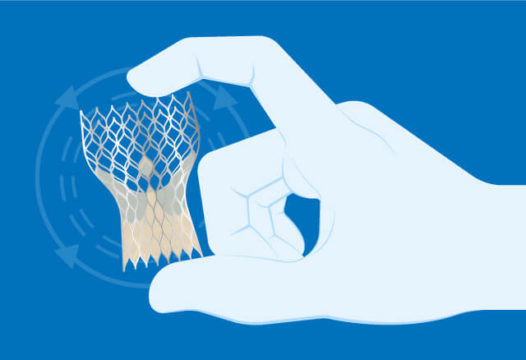Transcatheter aortic valve replacement (TAVR) by transfemoral access has shown great benefit for different risk groups, but its long-term durability is still uncertain.

Available evidence comes from small analysis and a single randomized trial with 280 patients and an 8 year follow-up: the NOTION Trial, where TAVR showed less valvular degeneration than aortic valve replacement (AVR) surgery.
In the SURTAVI study, 1660 patients with intermediate surgical risk were randomized to TAVR or AVR surgery. Among them, 864 underwent TAVR and 796, AVR.
The primary endpoint (PEP) for this analysis was all-cause mortality or incapacitating stroke at 5 years.
The most frequently used percutaneous valves were CoreVale (86%), followed by Evolut R (14%).
Population characteristics were similar: mean age was 79 years, 56% of patients were male, 34% had diabetes, 63% had coronary artery disease, 14% had had a prior infarction, 21% had undergone percutaneous coronary intervention (PCI), 16% had undergone myocardial revascularization surgery (MRS), 27% experienced atrial fibrillation, and 9% had undergone prior pacemaker implantation.
Read also: A Simple Score for Mortality and Cardiac Failure after Edge-to-Edge with MitraClip.
PCI revascularization was conducted in 13.1% of patients undergoing TAVR, and MRS was performed in 22.1% patients undergoing AVR.
The Society of Thoracic Surgeons mortality score was 4.4%.
There were no differences in the PEP at 5 years: 31.3% for TAVR vs. 30.8% for AVR (hazard ratio [HR]: 1.06; 95% confidence interval [CI]: 0.88-1.28; p = 0.55). Furthermore, there were no differences in all-cause mortality, cardiac death, debilitating stroke, infraction, endocarditis, valvular thrombosis, hospitalization due to heart failure, functional class, nor quality of life.
While the need for a pacemaker was higher at 2 years, there were no differences between the second and the fifth year.
The need for reintervention was higher in those who underwent TAVR within the first 2 years (21 [2.5%] vs. 4 [0.5%]; HR: 4.81; 95% CI: 1.65-14.0; log-rank p = 0.002), with no differences between the second and fifth year.
In the echocardiographic analysis, TAVR cases presented a larger valve area (2.2 cm2 vs. 1.8 cm2, p < 0.001), lower gradient (8.6 mmHg vs. 11.2 mmHg, p < 0.001) and less prosthetic mismatch 3.8% vs. 14% (risk difference: -10.26% [95%CI: -14.98% to -5.53%]; p < 0.001).
The presence of moderate to severe paravalvular leak was 3% for TAVR vs. 0.7% for AVR (risk difference: 2.37% [95% CI: 0.17%-4.85%]; p = 0.05).
Conclusion
Intermediate-risk patients with severe aortic stenosis at the 5-year follow-up showed a similar evolution in the presence of major clinical events with TAVR compared with surgery. TAVR was associated with a better hemodynamic profile but more paravalvular leaks and reinterventions.

Dr. Carlos Fava.
Member of the Editorial Board of SOLACI.org.
Original Title: Replacement in Intermediate-Risk Patients. 5-Year Outcomes of the SURTAVI Randomized Clinical Trial.
Reference: Nicolas M. Van Mieghem, et al. JAMA Cardiol. 2022;7(10):1000-1008. Self-expanding Transcatheter vs Surgical Aortic Valve.
Subscribe to our weekly newsletter
Get the latest scientific articles on interventional cardiology





